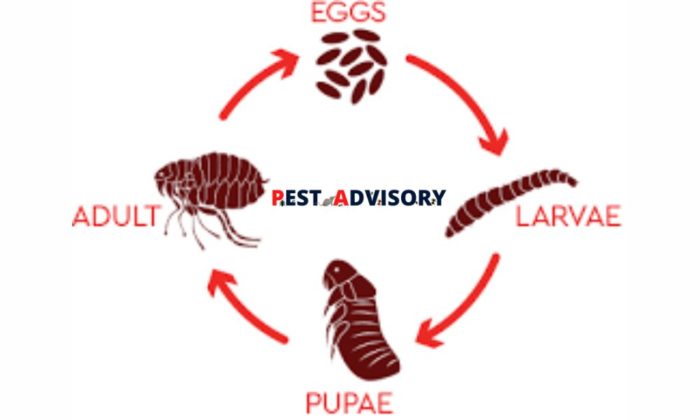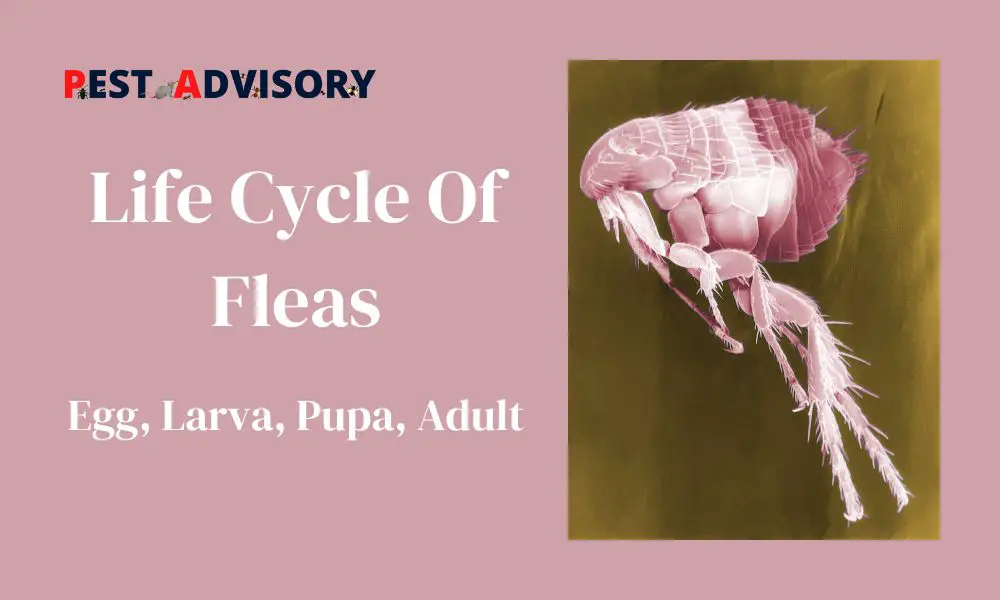You might have observed tiny reddish-brown insects in your home if you are a pet owner. These are nothing but parasitic creatures that make your pets their hosts.
There are certain stages in their lives. The food requirements and ways to kill them are different for each stage.
So, we have discussed the life cycle, feeding habits of fleas, and ways to kill them in this article.
How Fleas Reproduce
Fleas reproduce sexually, with males and females mating on the host animal. After mating, the female flea lays eggs on the host animal’s fur or skin, which then falls off and onto the ground or other surfaces.
Female fleas are capable of laying up to 50 eggs per day, and they typically lay their eggs in batches of 20-30 at a time. The eggs are small, oval-shaped, and white in color. They are coated with a sticky substance that allows them to adhere to the animal’s fur or skin.
It is important to note that flea reproduction can occur rapidly, with a single female flea capable of producing hundreds of offspring in just a few weeks. This can lead to rapid infestations if flea populations are not controlled.
Life Cycle of Fleas
Understanding the life cycle of any organism is necessary to disrupt it and eliminate its population.
There are four stages in the life cycle of fleas. They are eggs, larvae, pupae, and adult fleas. The average life span of fleas is 100 days, which is about 3 months.
An adult flea finds a suitable host and lays eggs after feeding on blood. The female flea lays eggs 36 to 48 hours after consuming blood.
Egg
Eggs hatch into larvae. It takes about 2 to 12 days for the eggs to hatch, depending on climate, humidity, and temperature.
Larva
The larvae further form a protective covering around them, which is a cocoon that converts into pupae. It protects them not only from environmental constraints but also from insecticides.
Pupa
The pupae convert into adult fleas in 7 to 20 days and come out of their cocoons when they have a host around them. They sense a host around them by the heat of blood or by movements.
Adult
The adult fleas once again start mating in favorable conditions and further increase their population.

The Table that summarizes the Lifecycle of Fleas
| Stage | Description | Duration |
|---|---|---|
| Egg | Flea eggs are oval, white, and about 0.5 mm long. They are laid on the host animal but can fall off onto the surrounding environment. | 2-12 days |
| Larva | Flea larvae are legless and worm-like. They feed on organic debris and the feces of adult fleas. | 5-18 days |
| Pupa | Flea pupae spin cocoons around themselves for protection. They can remain in this stage for several weeks or months. | 7-20 days (up to several months) |
| Adult | Fleas emerge from their cocoons as adults and immediately begin searching for a host animal to feed on. They can survive for several months without a host. | 2-4 weeks |
Feeding Habits of Fleas
The food consumed by every stage of fleas is slightly different. The larvae feed on blood and flea dirt, which is waste excreted by adult fleas.
The larvae also require eggs, vegetables, and other organic materials for their survival. It is found that only 12% of fleas that feed only on blood survive.
Adult fleas need blood for their survival from various hosts depending on their species. Several species of flea parasitize different hosts, including cats, dogs, birds, and even humans.
They need this blood to get energy and to continue their population. The flea dies in 3 to 12 days if it does not get blood.
Favorable Conditions And Environmental Factors For Fleas Infestation
| Environmental Factor | Impact on Fleas |
|---|---|
| Temperature | Ideal range is 70-85°F (21-30°C); less able to survive and reproduce below 50°F (10°C) or above 95°F (35°C) |
| Humidity | Ideal range is 70-85% relative humidity; flea eggs, larvae, and pupae may not survive in dry conditions |
| Availability of hosts | More common in areas with high populations of host animals, such as dogs, cats, or wildlife |
| Presence of other insects or pests | Large populations of other insects or pests, such as cockroaches or rodents, may provide more food sources for flea larvae, allowing them to survive and develop more easily |
| Cleanliness of environment | Fleas thrive in areas with organic debris, such as hair, skin flakes, and flea feces; regular cleaning and vacuuming can help remove these food sources and reduce the number of fleas in an area |
Eliminating Fleas
Fleas can cause diseases and even pandemics like the Bubonic Plague. Thus, getting rid of them should be your priority.
• You can use flea-repelling shampoos to bathe your pets. Use a fine-tooth comb later to remove the dead fleas.
• Use a vacuum cleaner to clean your home regularly. You can sprinkle cornstarch powder in your home a few hours before cleaning.
• You can also spray essential oils in your home after diluting them to repel fleas.
•Sprinkling crushed salt is also an effective method to kill fleas. Salt causes dehydration, and thus, it is effective against all stages of fleas.
Final Words
Contact a vet if the flea population is humongous, and do not ignore their presence. Also, do not use any oral medications on your pet without consulting a vet.
We hope that you got the desired information about fleas’ life cycle and the way to disrupt it. We wish you good luck in your flea elimination journey.
